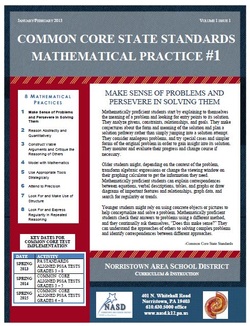SMP #1 Make sense of problems and persevere in solving them
Outstanding video illustrations of SMP in action in a 2nd grade, 4th grade, and 5th grade are available from InsideMathematics. See also the video from the Teaching Channel below.
The North Carolina Unpacked Standards provide a summary statement about the SMPs for each grade level:
Kindergarten: Mathematically proficient students in Kindergarten examine problems (tasks), can make sense of the meaning of the task and find an entry point or a way to start the task. Kindergarten students also begin to develop a foundation for problem solving strategies and become independently proficient on using those strategies to solve new tasks. In Kindergarten, students’ work focuses on concrete manipulatives before moving to pictorial representations. Kindergarten students also are expected to persevere while solving tasks; that is, if students reach a point in which they are stuck, they can reexamine the task in a different way and continue to solve the task. Lastly, at the end of a task mathematically proficient students in Kindergarten ask themselves the question, “Does my answer make sense?”
1st grade: Mathematically proficient students in Grade 1 examine problems (tasks), can make sense of the meaning of the task and find an entry point or a way to start the task. Grade 1 students also develop a foundation for problem solving strategies and become independently proficient on using those strategies to solve new tasks. In Grade 1, students’ work builds from Kindergarten and still heavily relies on concrete manipulatives and pictorial representations. The exception is when the CCSS uses to the word fluently, which denotes mental mathematics. Grade 1 students also are expected to persevere while solving tasks; that is, if students reach a point in which they are stuck, they can reexamine the task in a different way and continue to solve the task. Lastly, at the end of a task mathematically proficient students in Grade ask themselves the question, “Does my answer make sense?”
2nd grade: Mathematically proficient students in Grade 2 examine problems (tasks), can make sense of the meaning of the task and find an entry point or a way to start the task. Grade 2 students also develop a foundation for problem solving strategies and become independently proficient on using those strategies to solve new tasks. In Grade 2, students’ work still relies on concrete manipulatives and pictorial representations as students solve tasks unless the CCSS refers to the word fluently, which denotes mental mathematics. Grade 2 students also are expected to persevere while solving tasks; that is, if students reach a point in which they are stuck, they can reexamine the task in a different way and continue to solve the task. Lastly, mathematically proficient students complete a task by asking themselves the question, “Does my answer make sense?
3rd Grade: Mathematically proficient students in Grade 3 know that doing mathematics involves solving problems and discussing how they solved them. Students explain to themselves the meaning of a problem and look for ways to solve it. Third graders may use concrete objects or pictures to help them conceptualize and solve problems. They may check their thinking by asking themselves, “Does this make sense?” They listen to the strategies of others and will try different approaches. Students in Grade 3 will often use another method to check their answers.
4th Grade: Mathematically proficient students in Grade 4 know that doing mathematics involves solving problems and discussing how they solved them. Students explain to themselves the meaning of a problem and look for ways to solve it. Fourth graders may use concrete objects or pictures to help them conceptualize and solve problems. They may check their thinking by asking themselves, “Does this make sense?” They listen to the strategies of others and will try different approaches. They often will use another method to check their answers.
5th Grade: Mathematically proficient students in Grade 5 solve problems by applying their understanding of operations with whole numbers, decimals, and fractions including mixed numbers. They solve problems related to volume and measurement conversions. Students seek the meaning of a problem and look for efficient ways to represent and solve it. They may check their thinking by asking themselves, “What is the most efficient way to solve the problem?”, “Does this make sense?”, and “Can I solve the problem in a different way?”
The North Carolina Unpacked Standards provide a summary statement about the SMPs for each grade level:
Kindergarten: Mathematically proficient students in Kindergarten examine problems (tasks), can make sense of the meaning of the task and find an entry point or a way to start the task. Kindergarten students also begin to develop a foundation for problem solving strategies and become independently proficient on using those strategies to solve new tasks. In Kindergarten, students’ work focuses on concrete manipulatives before moving to pictorial representations. Kindergarten students also are expected to persevere while solving tasks; that is, if students reach a point in which they are stuck, they can reexamine the task in a different way and continue to solve the task. Lastly, at the end of a task mathematically proficient students in Kindergarten ask themselves the question, “Does my answer make sense?”
1st grade: Mathematically proficient students in Grade 1 examine problems (tasks), can make sense of the meaning of the task and find an entry point or a way to start the task. Grade 1 students also develop a foundation for problem solving strategies and become independently proficient on using those strategies to solve new tasks. In Grade 1, students’ work builds from Kindergarten and still heavily relies on concrete manipulatives and pictorial representations. The exception is when the CCSS uses to the word fluently, which denotes mental mathematics. Grade 1 students also are expected to persevere while solving tasks; that is, if students reach a point in which they are stuck, they can reexamine the task in a different way and continue to solve the task. Lastly, at the end of a task mathematically proficient students in Grade ask themselves the question, “Does my answer make sense?”
2nd grade: Mathematically proficient students in Grade 2 examine problems (tasks), can make sense of the meaning of the task and find an entry point or a way to start the task. Grade 2 students also develop a foundation for problem solving strategies and become independently proficient on using those strategies to solve new tasks. In Grade 2, students’ work still relies on concrete manipulatives and pictorial representations as students solve tasks unless the CCSS refers to the word fluently, which denotes mental mathematics. Grade 2 students also are expected to persevere while solving tasks; that is, if students reach a point in which they are stuck, they can reexamine the task in a different way and continue to solve the task. Lastly, mathematically proficient students complete a task by asking themselves the question, “Does my answer make sense?
3rd Grade: Mathematically proficient students in Grade 3 know that doing mathematics involves solving problems and discussing how they solved them. Students explain to themselves the meaning of a problem and look for ways to solve it. Third graders may use concrete objects or pictures to help them conceptualize and solve problems. They may check their thinking by asking themselves, “Does this make sense?” They listen to the strategies of others and will try different approaches. Students in Grade 3 will often use another method to check their answers.
4th Grade: Mathematically proficient students in Grade 4 know that doing mathematics involves solving problems and discussing how they solved them. Students explain to themselves the meaning of a problem and look for ways to solve it. Fourth graders may use concrete objects or pictures to help them conceptualize and solve problems. They may check their thinking by asking themselves, “Does this make sense?” They listen to the strategies of others and will try different approaches. They often will use another method to check their answers.
5th Grade: Mathematically proficient students in Grade 5 solve problems by applying their understanding of operations with whole numbers, decimals, and fractions including mixed numbers. They solve problems related to volume and measurement conversions. Students seek the meaning of a problem and look for efficient ways to represent and solve it. They may check their thinking by asking themselves, “What is the most efficient way to solve the problem?”, “Does this make sense?”, and “Can I solve the problem in a different way?”

Noristown Unified School District in Pennsylvania has published some outstanding newsletters which focus on each of the Standards for Mathematical Practice. SMP Newsletter #1 can be found here.
Thinkmath.edc.org has a discussion about SMP#1.
These videos from Teaching Channel show classroom putting SMP #1 into practice.
These videos from Teaching Channel show classroom putting SMP #1 into practice.
Click to set custom HTML
BigIdeasLearning has videos to demonstrate the math practices here.
InsideMathematics.org has additional video examples here.


